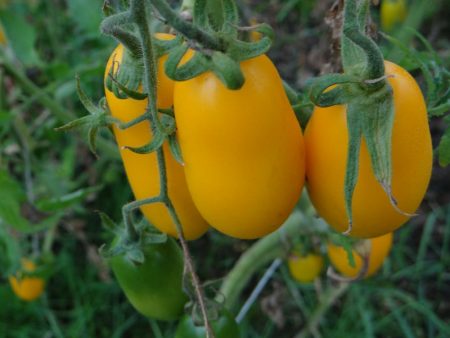
Tomato Orange icicle quickly became popular among Russian farmers. Yellow tomatoes are a good source of vitamin A, calcium, iron, sulfur, potassium, and vitamin C.Tomatoes of the Orange Icicle variety, as described, do not contain a powerful antioxidant, lycopene, famous in red counterparts. These are useful vegetables that should be planted by lovers of delicious tomatoes.
Feature and Features
Tomatoes Orange icicle - golden yellow, characterized by their meaty texture and large sizes, which are ideal for slicing vegetables. They are characterized by thick skin, which serves as a guarantee of protection during transportation over long distances. Tomatoes are juicy and fleshy, weighty flesh, have a high water content.
The variety needs the formation of several stems. Gardeners recommend making three stems. On the branches of the plant many fruits are formed, each of which has an oblong shape and a weight of 120 g. up to 200 gr. For this reason, the plant is tied so that it does not break under the weight of tomatoes and does not receive damage under the influence of winds.
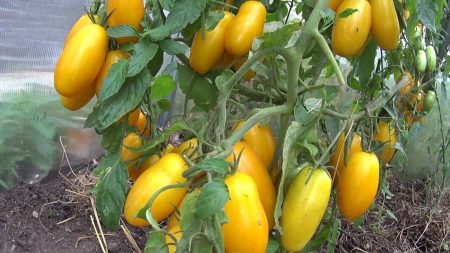
Tomatoes of the Orange Icicle variety, if we consider their characteristics more carefully, can be attributed to vegetables with a balanced taste. They are moderately sweet and often taste softer and less acidic than red tomatoes. Because pigments in tomato varieties produce different balances of sugars and acids. Thus, this is a unique combination of sugar and acidity, which explains the milder taste of yellow tomato Icicle. The variety is rarely grown for sale, but some gardeners manage to make big profits from using it for commercial purposes.
The bushes, which can reach a height of two meters, are characterized by abundant and prolonged bearing. If the gardener chooses the right time for planting the variety, then he guarantees himself a quality crop. It can be enjoyed most of the growing season of the plant. The fruits of the Orange Icicle variety are ideal for whole-canning.
Gardeners engaged in growing crops in the middle lane or southern regions can safely plant the plant in open ground. While in other regions of Russia it is recommended to grow in a greenhouse shelter. One bush can bring up to a dozen kilograms of fruit, which is quite good for an orange icicle of an identinant type.
Growing
- Seeds are sown preferably at the end of March. If necessary, you can wait until the beginning of April.
- Formed young plants are recommended to be transplanted into the open ground in the second decade of May.
- These subtropical plants need a good site for trouble-free growth, which is well lit.
- Tomato plants of the Orange Icicle, according to the characteristic, grow well in elevated soil layers. They value soil conditions that provide moisture without logging. In cooler regions, tomatoes are best grown under cover in a greenhouse. In cool conditions, the plant will not take root and form fruits.
- Tomatoes Orange icicles require fertile soil. The gardener should remember that a healthy culture can reach 2 meters in height and produce many fruits, occupying a small space.
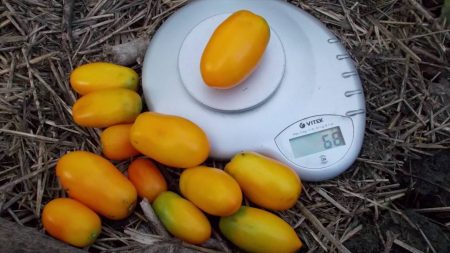
Tomatoes can be grown in pots, but due to the limited root space, an intensive feeding regimen will be required. Gardeners should make sure that the pots are designed for 40 liters. These conditions are not ideal, but may be the only option for growing on the balcony.
Best compost recommended. You can use liquid feed material in combination with organic fertilizer. Tomatoes respond well to inoculation with mycorrhizal fungi, which build a symbiotic relationship (benefits for both species) with the plant.
Mushrooms form a network of hyphae that transfer water and minerals to the Orange Icicle tomato plant in exchange for sugars produced by the roots. Mycorrhizal fungi are available in powder form for coating seedlings when planting or fiber, which is placed at the bottom of the planting container.
Care
- It is necessary to carefully water during planting, and then establish your own watering regime, taking into account external weather factors. As soon as the seedlings take root, she will need up to 12 liters of water per bush per week. It has been proven that a rare watering of the soil during the cultivation of the Orange Icicles variety improves the taste of the fruit. A gardener with such an irrigation scheme should be careful. Drought conditions, accompanied by intensive watering, can cause a growth spurt, which leads to cracked fruits. You will have to get used to watering over time.
- Many gardeners, according to reviews, grow Orange Icicles with perforated plastic bottles in the soil between the plants, which act as a water-absorbing reservoir. It is necessary to cut off the bottom of a 2-liter bottle and make numerous small holes in the sides. The bottle is immersed in the soil upside down with a lid and filled. Water will leak through the walls of the bottle and deeply moisturize the soil.
- As soon as the fruits on the bushes begin to form, the plant is fertilized weekly with liquid material with seaweed, which is most effective for feeding tomatoes.
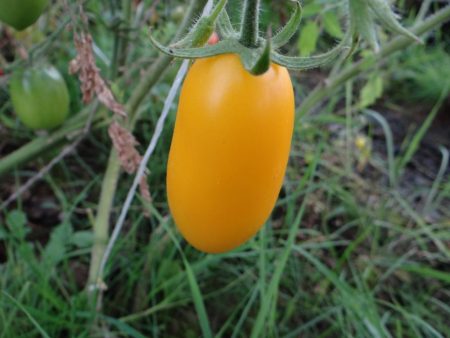
Grade problems
Few pests or problems are scary Yellow Icicles. Weather conditions and improper care can cause them. Leaf color changes are usually caused by nutrient deficiencies or low temperatures. Sometimes the problem is caused by two factors. Roots cannot absorb nutrients when the temperature drops. This can cause rot.
A common problem is cracked tomatoes due to improper watering. A balanced regular watering regime should solve this problem.
Calcium deficiency leads to darkening and often rotting areas around the base of tomatoes. The problem can be solved by adjusting the irrigation. As calcium absorption slows in drought conditions.
Magnesium deficiency causes yellowing of the leaves, while the streaks remain green. A good fertilizer will help fix the problem.
Whitefly is a likely pest that kills the fruit. Adult flies (they look like tiny moths) lay eggs on the underside of leaves. Growing eggs feed on leaves, leaving a sticky secretion that attracts disease. As soon as the gardener sees the eggs, they can be washed off with water or eliminated manually. There are tools available for use at the first sign of an attack.
Reviews
Anatoly:
“I love Orange icicles for ease of care.The plant only needs garter, it’s a laborious step in growing these tomatoes, otherwise everything is simple. ”
Helena:
“I love the variety for their taste and neat appearance. I sell tomatoes to my friends Orange icicles. "Tomatoes bring so much fruit that my family and I no longer know where to put them."
Valeria:
“A wonderful plant that gives a stable and high-quality crop. Of course, storing orange icicles for a long time is difficult. Over time, they lose their rich taste and delicate aroma. But, ripped tomatoes from the garden, sliced to the table are simply gorgeous. ”
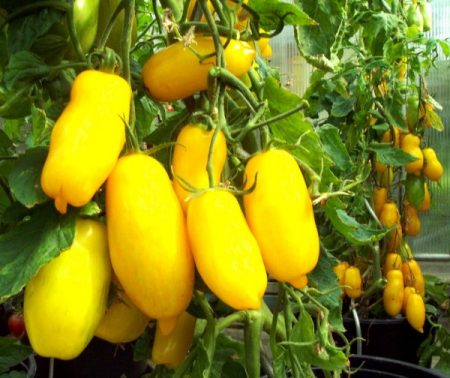
Denis:
“Yellow icicles are my favorite. Last year, the crop was slightly spoiled due to whiteflies, did not respond to the attack on time. This year, I immediately stocked up with high-quality preparations for plant treatment. ”
Evgeniy:
“Orange icicles quickly became my favorite tomatoes, not only because of the excellent taste, but also the fruiting of the bushes. It’s enough to plant a little bit to provide yourself with tasty, sweet fruits for the whole summer. ”
Maria:
“For three years in a row I have been landing Orange Icicles. The variety has not yet disappointed with either taste or quantity of fruits. ”




 Low-growing tomatoes, without pinching: 5 of the most delicious varieties
Low-growing tomatoes, without pinching: 5 of the most delicious varieties Why tomato seedlings grow poorly
Why tomato seedlings grow poorly We grow a tomato in a shell
We grow a tomato in a shell Growing tomatoes without watering according to the method of Kazarin
Growing tomatoes without watering according to the method of Kazarin